It's no secret that SEOs want to ensure the greatest visibility in the Google search results for their brand. One way to achieve this is through the use of long-tail keywords.
We know that complete topic authority in a brand niche or market is achieved by covering all aspects of the topic in full. Therefore, uncovering the full scope of keywords to target — including the phrases focused on highly specific information — unlocks the true goldmine of SEO potential.
Coincidentally, this is the most popular keyword type today's searchers are using to find your business, so allow me to show you how to unlock that potential and drive users to your site content.
In this post, you can expect to learn:
- What Are Long-Tail Keywords?
- Why You Should Focus on Long-Tail
- How to Find Long-Tail Terms - My 2 Methods
- How to Use Long-Tail Keywords in Your Content
What Are Long-Tail Keywords?
Long-tail keywords are longer search phrases that contain at least three words and focus on highly-specific information.
Because of those characteristics, long-tail keywords typically have smaller search volume. Fewer people type those specific phrases into search engines, making long-tail phrases seem less attractive in an SEO strategy.
However, customers are more likely to use long-tail keywords when they are closer to making a buying decision (or use voice search).
Someone searching for a head term (a generic, category-like keyword with potentially vast meaning) is, most likely, only researching the concept. A person asking a specific question about a product, on the other hand, is gathering specific information to make a more informed buying decision.
Let me illustrate that with an example: Imagine that you run a store that sells earbuds. Your main focus is on the head term – earbuds – of course. You want to attract as many customers searching for information about the product online.
But you know that targeting just the phrase earbuds isn’t enough, and judging by the 75 million results in a quick Google search, you're probably never going to rank for that term alone.
 (That's a lot of search results for your head term!)
(That's a lot of search results for your head term!)
Armed with this understanding, you include other search term types in your SEO strategy as well. For example, you target category-level keywords, too, like: wireless earbuds, noise-canceling earbuds, Apple earbuds, and so on.
Now, I agree that those phrases cover a lot of the topic, but they certainly don’t include everything a potential customer might want to know about the product.
This is where your long-tail keywords come into play!
Long-tail keywords help you expand each of those categories. By incorporating them into your strategy, you ensure that you cover the topic to its fullest, regardless of the user intent you target.
Let’s go back to our earbuds store example. Long-tail keywords help you target both intent to buy and intent to know. Example phrases to target for the commercial intent might include best true wireless earbuds, best Bluetooth earbuds, earbuds for swimming, earbuds for running — just to name a few.
Then, when targeting the informational intent to influence their research, you can offer advice on how to select the right earbuds, how to wear apple earbuds, or how to charge wireless earbuds, and so on.
In each of the examples of long-tail keywords above, I should note that these are actual keywords I discovered quickly using SEO topic research in the seoClarity platform.
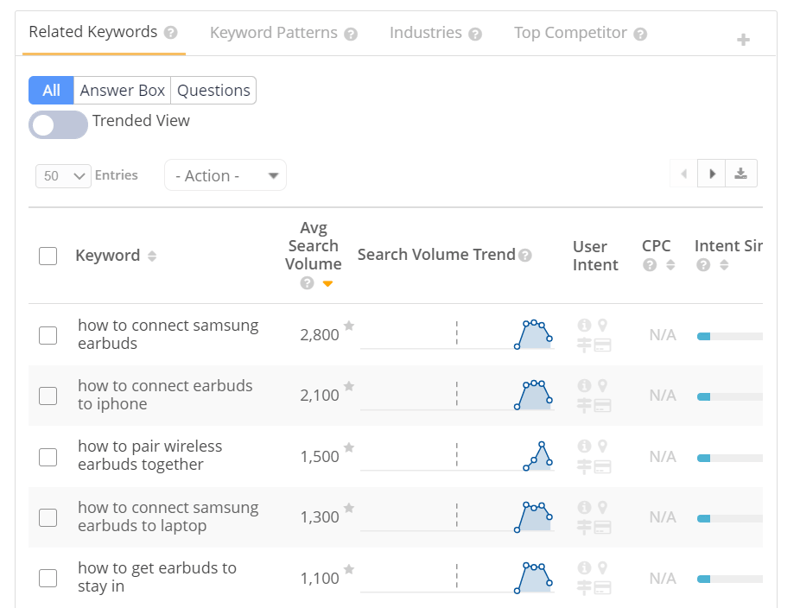 (Topic Explorer report showing long-tail keywords along with associated data.)
(Topic Explorer report showing long-tail keywords along with associated data.)
Why Focus on Long-Tail Keywords?
There are three good reasons to pay attention to long-tail keywords. They …
#1. Form the majority of search queries today
With the rise of voice search and advancements to Google that allow users to search the way we want, we’ve grown accustomed to using custom queries. We ask Google questions (sometimes even out loud!), we give the search engine scraps of information about the topic of our search, we specify the object of our search thoroughly … And, you know what?
This works! Doing so often requires using long search queries.
#2. Are easier to rank since fewer websites compete for them
Unfortunately, the myth that a brand should focus on its head terms only still prevails among many SEOs. All the while longer phrases offer an incredible opportunity to expand their search visibility much quicker.
#3. Attract a more engaged audience
These queries focus on highly-specific information. As a result, there is less chance of attracting a random visitor or someone who is unsure of what they're seeking.
Anyone searching for best wireless earbuds for running is, from what we can assume about the buyer, quite deep into the buying journey. We cannot be as certain however about a person typing earbuds into the search box.
How to Find Long-Tail Keywords: The Process and Tools to Use
So, how do we begin to find long-tail keywords that work for our strategy? Marketers and SEOs can find longer search phrases in two ways:
- Manually, or
- By using dedicated SEO tools.
Method #1: Manual Research
Google offers a few keyword tools to uncover long-tail phrases.
Autosuggest is one of them. Typing the head term into the search box will yield long-tail keyword suggestions immediately. These could make for great keyword ideas!
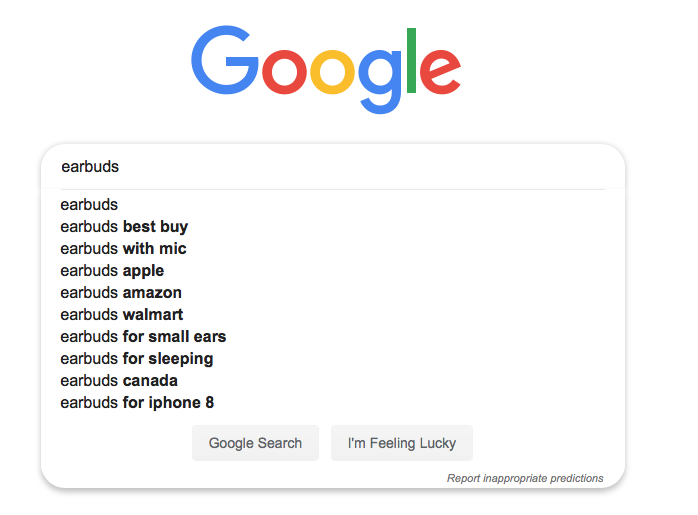 (Are you really feeling lucky doing manual research for long-tail keywords?)
(Are you really feeling lucky doing manual research for long-tail keywords?)
Scrolling to the bottom of the SERP will reveal searches related to the head term. Many of these related keywords will be long-tail.
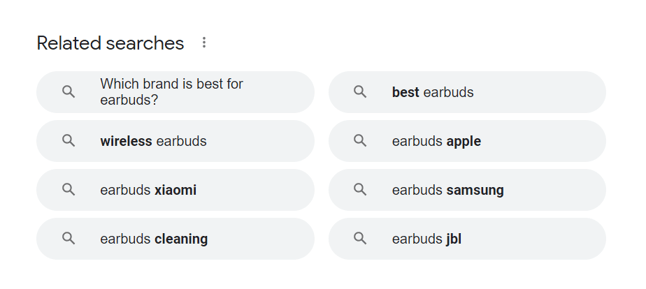 (People search for these queries around earbuds, too.)
(People search for these queries around earbuds, too.)
Many queries trigger the "People Also Ask" section in SERPs. Questions listed there include great long-tail keywords as well.
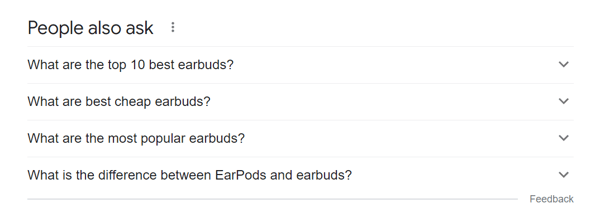
(People Also Ask highlights related searches.)
Similarly, question-and-answer sites like Quora can reveal what specific questions your audience asks about their topics of interest.
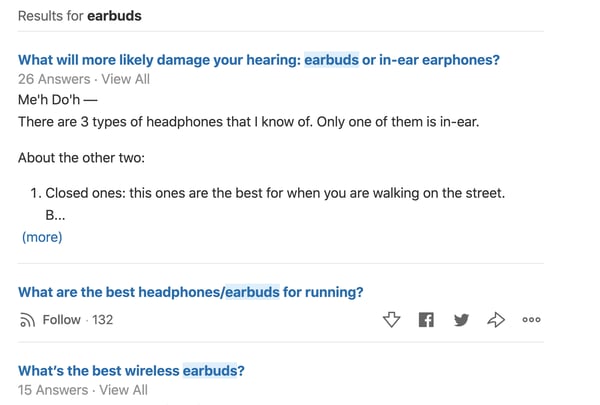
(Online forums show how people talk about specific phrases.)
Wikipedia entries can help find many long-tail keyword as well. This single section of an article on headphones provides a whole range of long-tail phrases our earbuds store could research further. And that's what I've found in just one section in the entire Wikipedia entry!
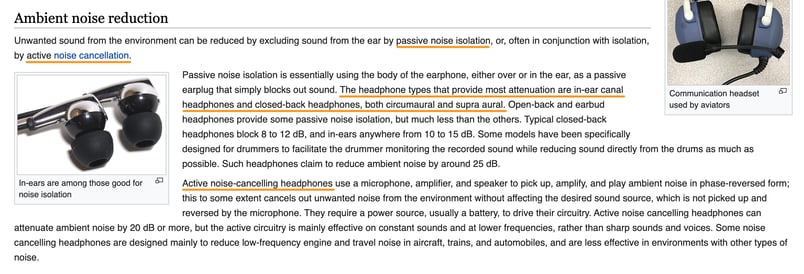 (Great information is available right on Wikipedia!)
(Great information is available right on Wikipedia!)
But as you might have guessed in reading this, there is a major flaw in the approach above. It’s time-consuming!
Plus, going through the process manually never reveals the complete insight into what searchers want to know. Luckily, there's another method to follow.
Method #2: Use a Dedicated Keyword Research Tool
A keyword research tool gives you access to a large portion of the search landscape, so a number of keyword opportunities are only a few clicks away — long-tail included!
Your tool of choice should give you the ability to filter, slice, and dice the data accordingly so you can find the insights you're after. For the images below, I'll demonstrate with the seoClarity platform, which now has the largest keyword data set available.
That's right: Access more keywords than anywhere else.
More than 30 billion keywords, in fact!
Your keywords are in there, so allow me to demonstrate how the data set allows us to find those valuable long-tail keywords with Topic Explorer, our SEO topic research tool.
After we search for the head term (as you would normally) we want to filter the word count to display phrases that are longer than 2 words.
Then, set the Word Count filter to display phrases that are longer than 2 words only.
Based on this simple tweak, Topic Explorer filters out any keywords that don’t match the above criteria. The result will be a list of long-tail keywords only.
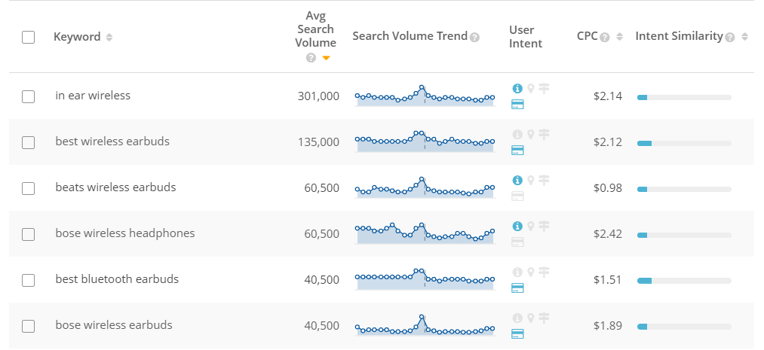
(Voilà! Here are the results provided by Topic Explorer.)
The topic research doesn’t stop there. You can filter the results further by the user intent and identify phrases that most closely match your campaign, or set criteria for search volume, SERP features, or the overall topic.
You can also review common keyword patterns. With this, you can plan a long-term content strategy in rapid time.
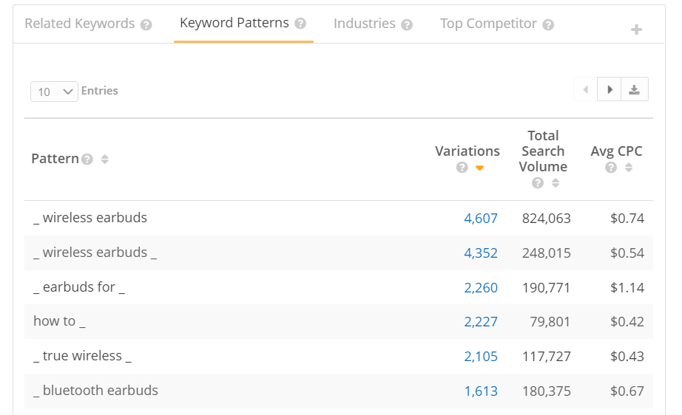
(Find keyword variations and patterns for even more content ideas.)
You can even see which phrases relate to your target audience or industry!
If my focus was on targeting athletes or sports-minded users, I can verify the most relevant long-tail keywords used in that industry:

(Sort by industry to focus on phrases relevant to your business.)
As a result, I don’t run into a risk of targeting phrases my potential customers actually don’t use.
Finally, you can research the competition’s keywords. Topic Explorer will not only tell you what other domains target those phrases, it will also deliver a list of all of the long-tail keywords they use in their content.
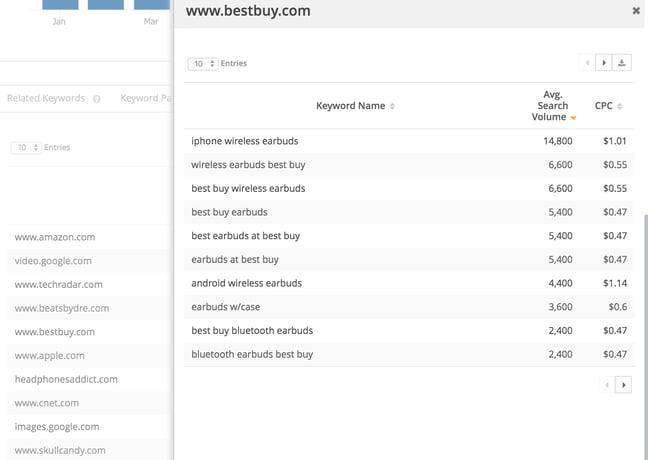
(Find what your competitors rank for - and potentially optimize for those terms!)
How to Use Long-Tail Keywords in Your Content
There are different ways you can target long-tail keywords. Before we talk about using long-tail phrases to rank higher, we need to distinguish between two different types of such phrases:
- Long-tail keywords that focus on specific information, and
- Such phrases that only expand on a head term.
Let me explain the difference.
The first group includes keywords and questions that focus on gaining a specific answer. Long-tail keywords like the best earbuds for running ask a specific question that you should answer with a dedicated blog post or page.
But a phrase like this what will damage your hearing more, earbuds or headphones? could easily be a part of a bigger question, for example: what makes earbuds better than standard headphones? As a result, this information can reside on another page, and still rank for that phrase and attract relevant traffic.
So, when using long-tail keywords in content, you must decide whether a particular phrase requires a dedicated page or could be targeted and optimized for with other content. Then, you either create that page, making the long-tail keyword the target phrase. Or you expand an existing content with information that will allow you to rank for the phrase also.
TIP: Topic Explorer's proprietary Intent Similarity metric scores the underlying intent between your head term and the keyword results, allowing you to determine if a phrase deserves its own page or not.
Tap Into Your Keyword Goldmine
Once you dive deep into your long-tail keywords, you're sure to see the benefits of a long-tail keyword goldmine, such as:
- Greater visibility in a search thanks to greater topic authority, and
- More interested and qualified users on your site
See firsthand how Topic Explorer will transform your SEO strategy and overall topic authority: Schedule a quick chat!
GET TO KNOW THE AUTHOR, MARY KATE MACK
Editor's Note: This post was originally published in October 2019 and has been updated with the latest and most accurate information.



.png?width=140&name=Untitled%20design%20(10).png)



1 Comment
Click here to read/write comments